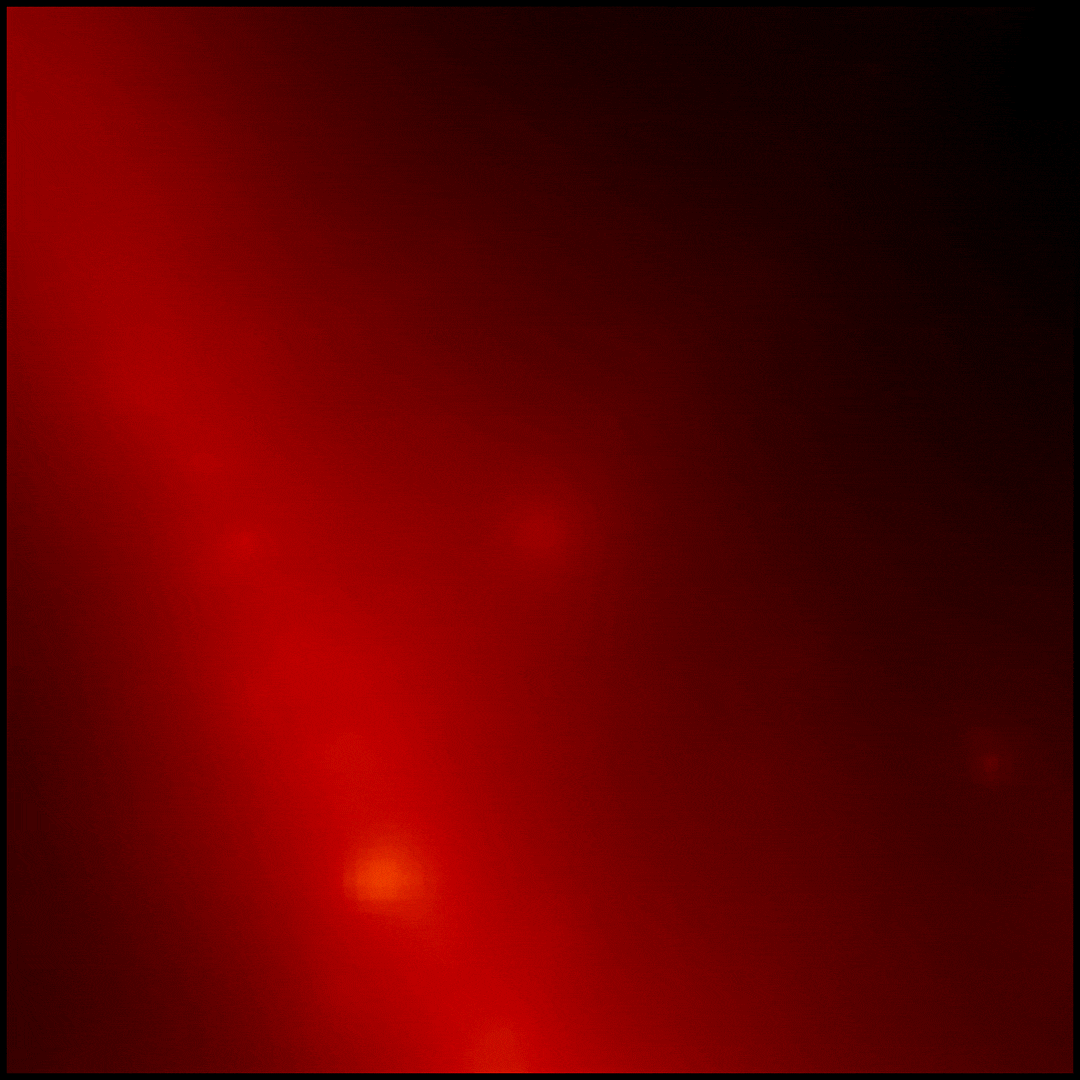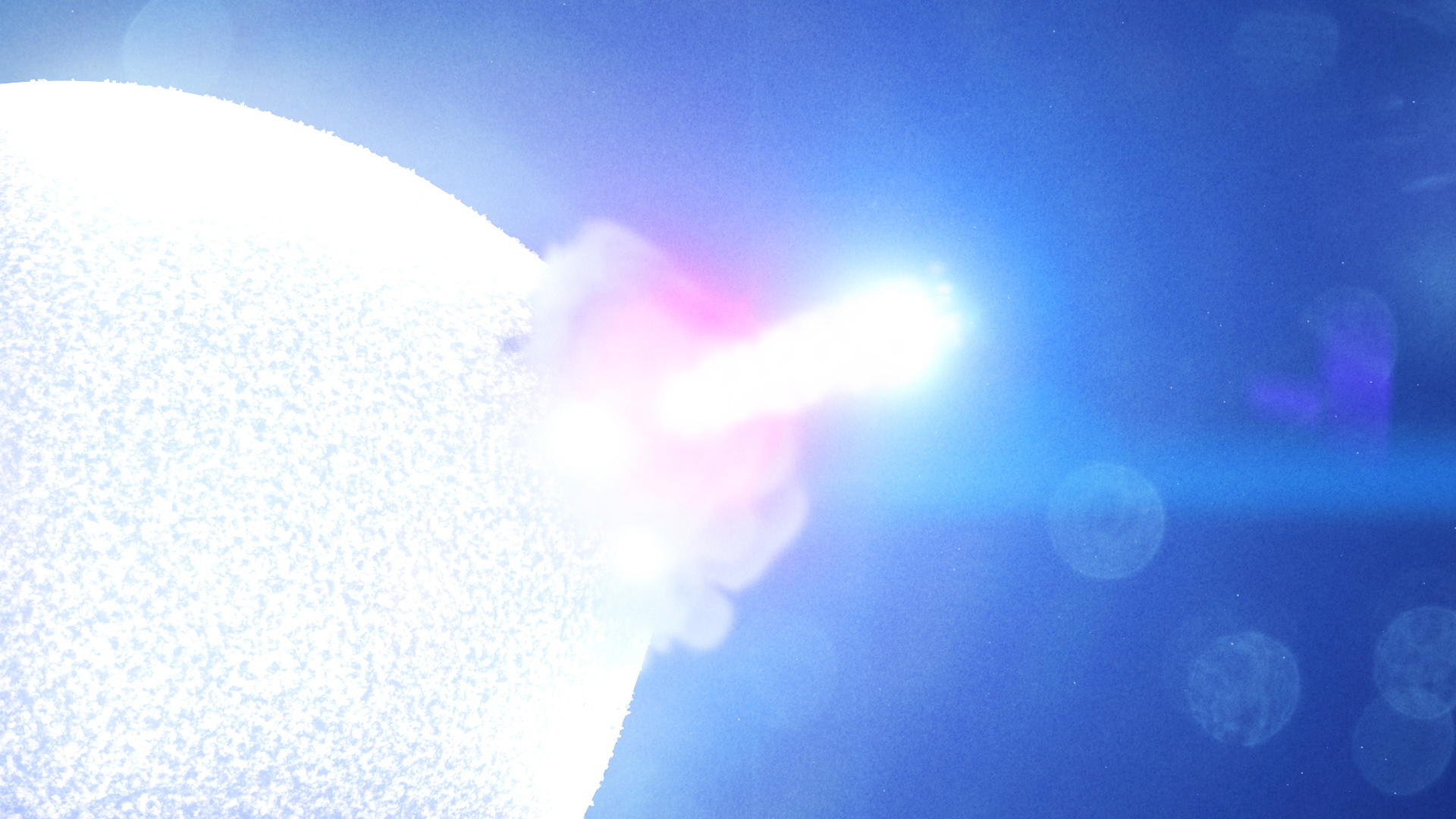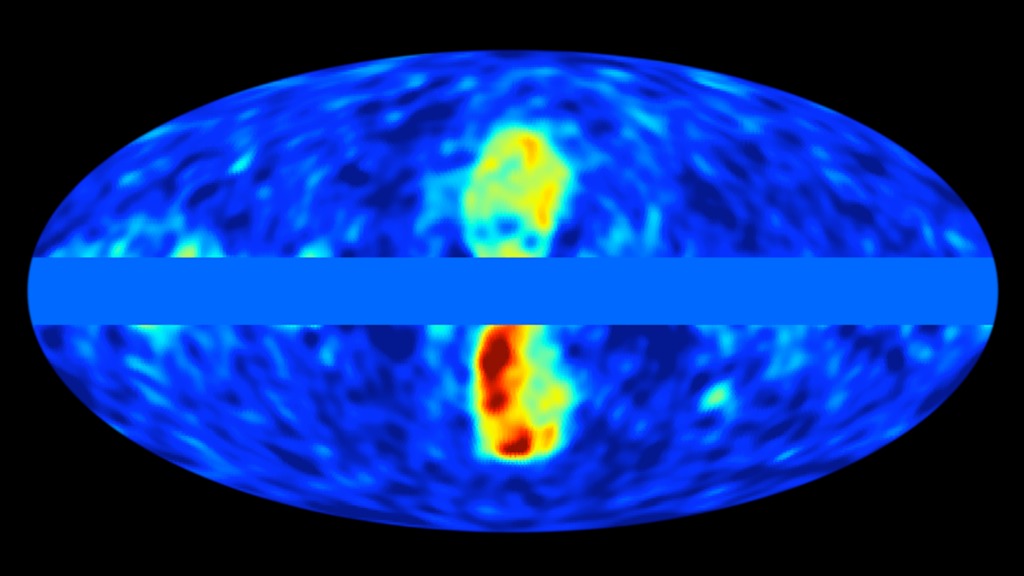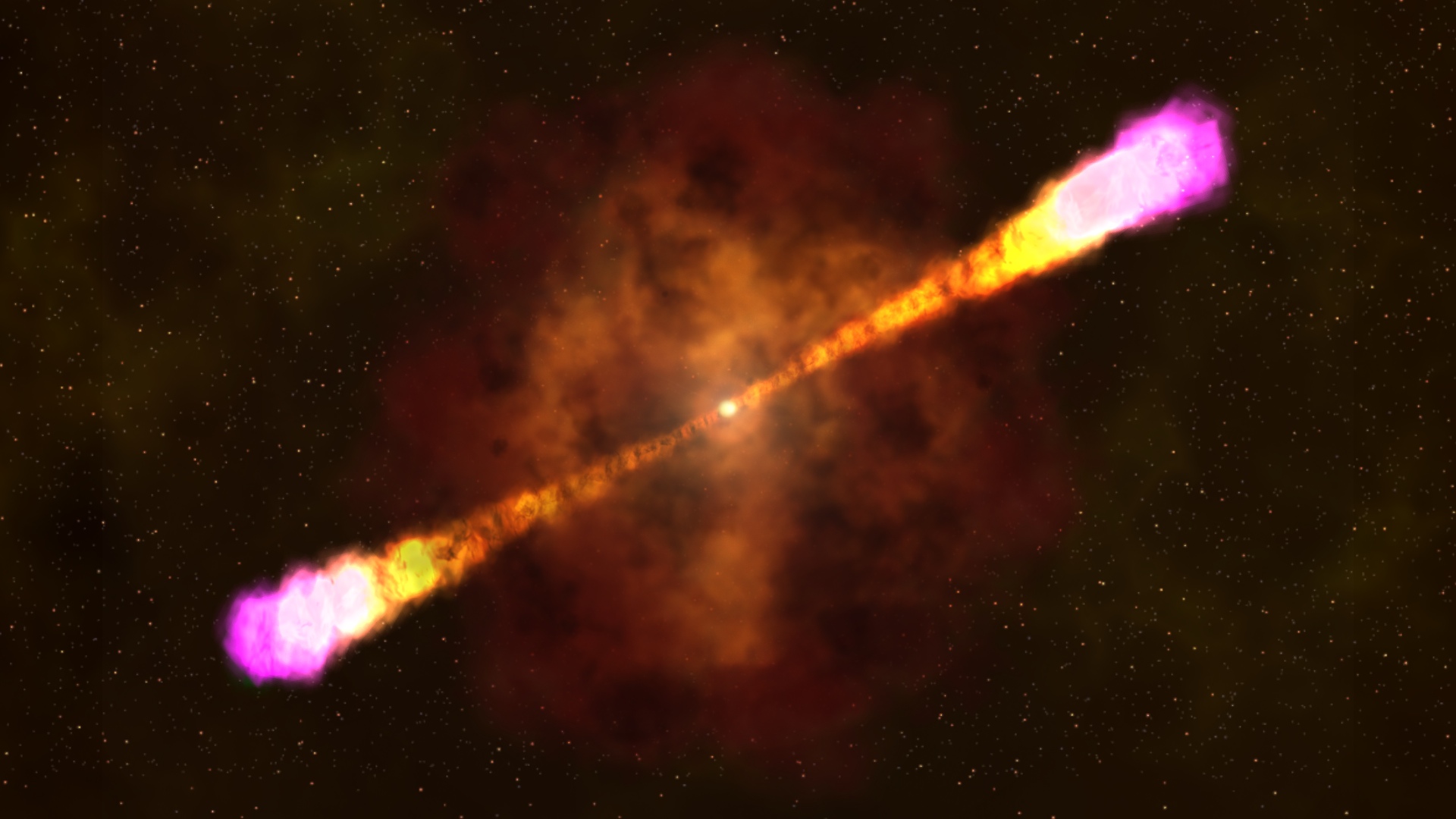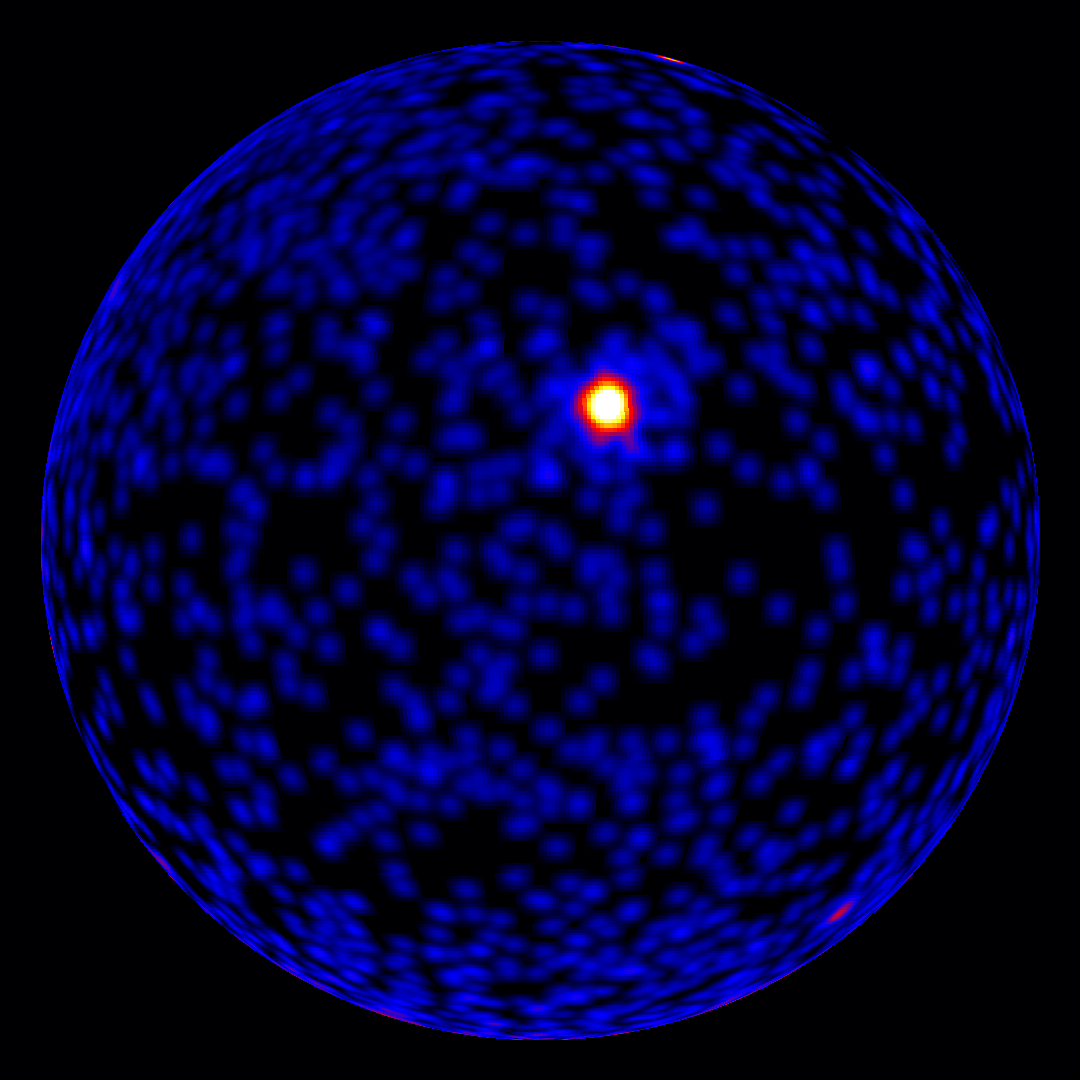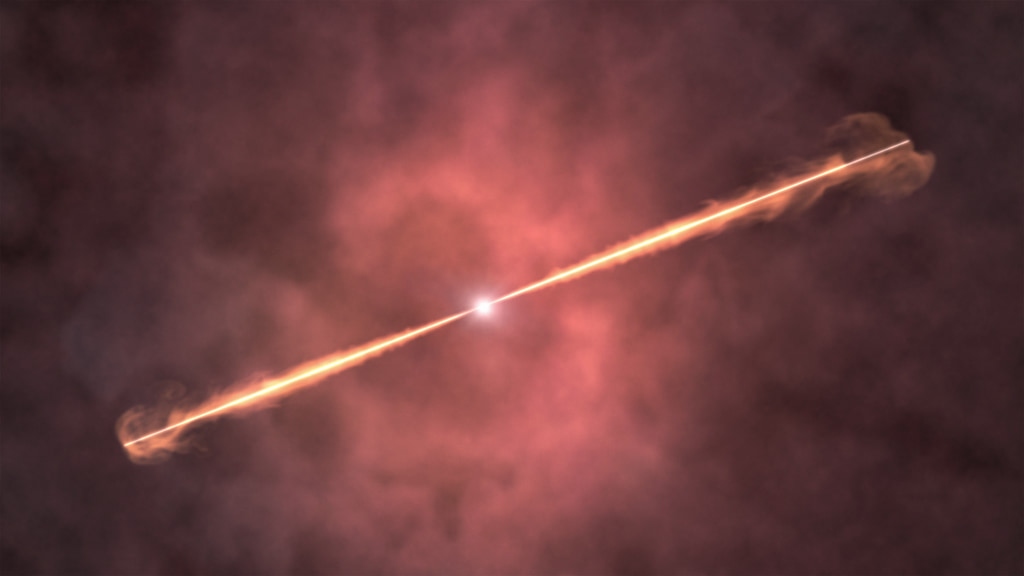NASA Missions Probe What May Be a 1-In-10,000-Year Gamma-ray Burst

The Hubble Space Telescope’s Wide Field Camera 3 revealed the infrared afterglow (circled) of the BOAT GRB and its host galaxy, seen nearly edge-on as a sliver of light extending to the burst's upper left. This animation flips between images taken on Nov. 8 and Dec. 4, 2022, one and two months after the eruption. Given its brightness, the burst’s afterglow may remain detectable by telescopes for several years. Each picture combines three near-infrared images taken at wavelengths from 1 to 1.5 microns and is 34 arcseconds across.
Credit: NASA, ESA, CSA, STScI, A. Levan (Radboud University); Image Processing: Gladys Kober
On Tuesday, March 28, 2023, astronomers meeting at the High Energy Astrophysics Division meeting of the American Astronomical Society in Waikoloa, Hawaii, presented new findings about the BOAT – the brightest of all time gamma-ray burst that erupted in October 2022.
Gamma-ray bursts are the most powerful class of explosions in the universe. The BOAT triggered detectors on numerous spacecraft, and observatories around the globe followed up. Observations of the burst span the spectrum, from radio waves to gamma rays, and include data from many NASA and partner missions, including the NICER X-ray telescope on the International Space Station, NASA’s NuSTAR observatory, and even Voyager 1 in interstellar space.
The signal from GRB 221009A had been traveling for about 1.9 billion years before it reached Earth, making it among the closest-known “long” GRBs, whose initial, or prompt, emission lasts more than two seconds. Astronomers think these bursts represent the birth cries of black holes that formed when the cores of massive stars collapsed under their own weight. As it quickly ingests the surrounding matter, the black hole blasts out jets in opposite directions containing particles accelerated to near the speed of light. These jets pierce through the star, emitting X-rays and gamma rays as they stream into space.
NASA's James Webb and Hubble space telescopes searched for the supernova usually found after long bursts, so far to no avail. Observations will continue, but astronomers say it's possible the entire star was swallowed up by the black hole instead of exploding.
The burst is among the closest long GRBs. The jets themselves were not unusually powerful, but they were exceptionally narrow – much like the jet setting of a garden hose – and one was pointed directly at us. The closer to head-on we view a jet, the brighter it appears.
The burst also enabled astronomers to probe distant dust clouds in our own galaxy. As the prompt X-rays traveled toward us, some of them reflected off of dust layers, creating extended “light echoes” of the initial blast in the form of X-ray rings expanding from the burst’s location. The X-ray Telescope on NASA’s Neil Gehrels Swift Observatory discovered the presence of a series of echoes. Detailed follow-up by ESA’s (the European Space Agency’s) XMM-Newton telescope, together with Swift data, revealed these extraordinary rings were produced by 21 distinct dust clouds.
Astronomers may be able to study the afterglow of this astonishing GRB for years to come.

The Hubble Space Telescope’s Wide Field Camera 3 revealed the infrared afterglow (circled) of the BOAT GRB and its host galaxy, seen nearly edge-on as a sliver of light extending to upper left from the burst. This composite incorporates images taken on Nov. 8 and Dec. 4, 2022, one and two months after the eruption. Given its brightness, the burst’s afterglow may remain detectable by telescopes for several years. The picture combines three near-infrared images taken each day at wavelengths from 1 to 1.5 microns and is 2.2 arcminutes wide.
Credit: NASA, ESA, CSA, STScI, A. Levan (Radboud University); Image Processing: Gladys Kober

Unannotated versions of the Hubble Space Telescope’s Wide Field Camera 3 afterglow image (GIF, JPEGs, and TIF).
Gamma-ray bursts are the most luminous explosions in the cosmos. Astronomers think most occur when the core of a massive star runs out of nuclear fuel, collapses under its own weight, and forms a black hole, as illustrated in this animation. The black hole then drives jets of particles that drill all the way through the collapsing star at nearly the speed of light. These jets pierce through the star, emitting X-rays and gamma rays (magenta) as they stream into space. They then plow into material surrounding the doomed star and produce a multiwavelength afterglow that gradually fades away. The closer to head-on we view one of these jets, the brighter it appears.
Credit: NASA's Goddard Space Flight Center
Find 4k master copies here.

GRB 221009A stands tall among previous record-setting long gamma-ray bursts.
Credit: Adam Goldstein, USRA

XMM-Newton images recorded 20 dust rings, 19 of which are shown here in arbitrary colors. This composite merges observations made two and five days after GRB 221009A erupted. Dark stripes indicate gaps between the detectors. A detailed analysis shows that the widest ring visible here, comparable to the apparent size of a full moon, came from dust clouds located about 1,300 light-years away. The innermost ring arose from dust at a distance of 61,000 light-years on the other side of our galaxy. GRB221009A is only the seventh gamma-ray burst to display X-ray rings, and it triples the number previously seen around one.
Credit: ESA/XMM-Newton/M. Rigoselli (INAF)

X-rays from the initial flash of GRB 221009A could be detected for weeks as dust in our galaxy scattered the light back to us. This resulted in the appearance of an extraordinary set of expanding rings. Images captured over 12 days by the X-ray Telescope aboard NASA’s Neil Gehrels Swift Observatory were combined to make this movie, shown here in arbitrary colors.
Credit: NASA/Swift/A. Beardmore (University of Leicester)

Same as above but without labels.
Credit: NASA/Swift/A. Beardmore (University of Leicester)
The BOAT burst enabled astronomers to probe distant dust clouds in our own galaxy. As the X-rays from the initial blast traveled toward us, some of them reflected off of dust layers, creating extended “light echoes” in the form of X-ray rings expanding from the burst’s location. This animation shows how it happens. The scattered X-rays travel to us with a slight delay. As seen from Earth, we first see the burst followed by the expanding rings. How dust clouds scatter X-rays depends on their distances, the sizes of their dust grains, and the X-ray energies involved.
Credit: NASA’s Goddard Space Flight Center

This illustration shows the BOAT GRB's location (cross) as seen from Earth and our line of sight to it through our Milky Way galaxy.
Credit: NASA's Goddard Space Flight Center

GRB 221009A appeared in the constellation Sagitta, within the dust-rich central plane of our galaxy, as shown in this illustration. The bright star at upper left is Vega.
Credit: NASA's Goddard Space Flight Center

GRB 221009A appeared in the constellation Sagitta, within the dust-rich central plane of our galaxy, as shown in this illustration. The bright star at upper left is Vega.
Credit: NASA's Goddard Space Flight Center

This illustration shows the locations of the dust layers associated with the five smallest X-ray rings (inset, circled) from the BOAT GRB. Our Milky Way galaxy is shown in side (top) and plan views. The thick line shows the direction to the burst, and dark patches within it represent the dust layers responsible for producing the X-ray rings. The smallest ring corresponds to the most distant dust, located about 61,000 light-years away from the Sun and 4,600 light-years above the galaxy's midplane.
Credit: NASA's Goddard Space Flight Center

Unlabeled version of the above.
Credit: NASA's Goddard Space Flight Center
Polarization measures the organization of electromagnetic radiation, that is, how well the light waves line up. When fast-moving charged particles spiral along magnetic fields, as shown in this animation, they produce highly organized light called synchrotron radiation. Exploring the polarization of gamma-ray bursts allows astronomers to probe the geometry of magnetic fields within the jets of gamma-ray bursts, providing information about what mechanism close to their black holes generated them.
Credit: NASA’s Goddard Space Flight Center

Voyager 1, located 14.7 billion miles from Earth, detected the BOAT GRB on Oct. 8, 2022.
Credit: NASA's Eyes on the Solar System

The ESA (European Space Agency) missions Gaia and INTEGRAL detected the BOAT's intense pulse of high-energy radiation as it approached Earth on Oct. 9, 2022.
Credit: NASA's Goddard Space Flight Center

The Gamma-ray Burst Monitor on NASA's Fermi Gamma-ray Space Telescope triggered on the BOAT just before 9:17 a.m. EST, and the wave of high-energy radiation was detected on Earth by ground-based gamma-ray observatories. NASA's Swift satellite missed the show because Earth was blocking its view. The burst's afterglow was so bright that, almost an hour later, Swift's Burst Alert Telescope was triggered by it.
Credit: NASA's Goddard Space Flight Center

NASA's Wind and Advanced Composition Explorer satellites, stationed almost a million miles sunward of Earth, detected the BOAT GRB about 1.2 seconds after the pulse of energy swept past Earth.
Caption: NASA's Goddard Space Flight Center

NASA's Mars Odyssey and MAVEN spacecraft at Mars detected the BOAT about 3.9 minutes after its energy swept over Earth.
Credit: NASA's Goddard Space Flight Center
For More Information
See NASA.gov
Credits
Please give credit for this item to:
NASA's Goddard Space Flight Center. However, individual items should be credited as indicated above.
-
Science writer
- Francis Reddy (University of Maryland College Park)
-
Producer
- Scott Wiessinger (KBR Wyle Services, LLC)
-
Graphics
- Francis Reddy (University of Maryland College Park)
-
Animator
- Scott Wiessinger (KBR Wyle Services, LLC)
-
Scientists
- Brad Cenko (NASA/GSFC)
- Eric Burns (Louisiana State University)
Release date
This page was originally published on Tuesday, March 28, 2023.
This page was last updated on Wednesday, May 3, 2023 at 11:43 AM EDT.

